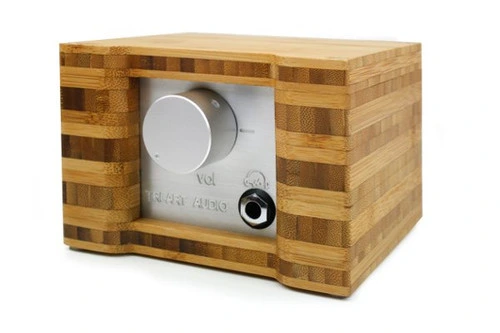Demo price only $260! Originally $325, you save $65! That's 20%!
Derived in concept from Tri-Art's P-Series, The S Series Headphone amplifier design works perfectly with low impedance headphones but really shines when connected to high end high impedance headphones. Although musicality is their ultimate goal, the specs for this unit are impressive. With an output resistance of 75 ohms and virtually unmeasurable THD <0.001 combined with a SNR of >100db, matched to a quality source component. As with all Tri-Art's products, they eschew plastic components for natural materials of bamboo, sheep's wool, beeswax, and hemp.
BambooTri-Art Audio has selected bamboo to construct many of the structural parts of their systems rather than the industry standard of metal or plastic. In addition to its natural aesthetics, it has a vital function: A constrained layer plywood variant is employed for its performance abilities. It is very stiff for excellent rigidity with the ability to dampen vibration. It is non-magnetic, providing a quieter electrical environment for their amplifier circuitry. An eco-friendly resource, some variants of bamboo are capable of growing up to a meter (39 inches) per 24 hours period!
WoolThe interior of Tri-Art's amplifiers are packed with locally sourced, unbleached, sheeps wool due to its ability to reduce sound transfer and vibrations, insulate, and natural heat resistance. Wool fibers are particularly effective at dampening airborne vibrations and preventing them from affecting the performance of Tri-Art's amplifier chip. The temperature stability of the system (class D) and insulating properties of the wool have the benefit of eliminating heat sinks. Wool also eliminates the need for fans which are both mechanically and electrically noisy.
Concrete BrickTri-Art developed their locally manufactured concrete brick using a blend of cement and plastic fibers to re-enforce its strength, make it lighter in weight, and more porous. Concrete absorbs sound frequencies and resonates at a narrow high-frequency, and its porosity allows for sound absorption.
Class D ChipTri-Art's design criteria for the S-Series MM phono amplifier was to design a good phono amplifier for a modest investment. They met the criteria for a modest investment, but overachieved on the sound quality. With a MM gain of 63 db gain and a unique op amp that to Tri-Art's knowledge has never been used with an audio component. Featuring an RF shield as well as RF filtering and a 3-stage subsonic filter, the sound is warm and clean and quote lifelike. Component selection was critical, and they completed the amp without the use of carbon resistors or ceramic capacitors.
Capacitor BanksClass D amplifiers are particularly sensitive to any anomalies in their supply voltage. Although Tri-Art uses an exceptionally good power supply, they have decided to go the extra mile and incorporate a capacitor bank ensuring sufficient current will be available to the chip to deal with high transient demand conditions. Multiple smaller capacitors in a bank can be preferable to a single large capacitor, mostly for reasons of speed, but these must be very carefully designed to avoid the generation of eddy currents. By strategically deploying small amounts of resistance to balance transient draw, Tri-Art has created conditions antithetical to the formation of eddy currents.
Naked ComponentsAll electronic components on Tri-Art's circuit boards have had their outer skin (plastic shrink identifying wrapping) removed. And for good reason: Tri-Art discovered during their listening tests that stripping away plastic wrapping removes the sonic characteristics plastic brings to the electronic component. They remove as much associated materials as possible that have negative sonic signatures.
Power SupplyThe power supply is by far the noisiest section electrically in all amplifier designs. The single most important fact about Tri-Art's DC Linear Power Supplies is that they are housed in their own enclosure, physically separated from other units. Instead of the less costly and more commonly used Switching Power Supply, Tri-Art uses a Linear Power Supply which are five orders of magnitude (10 000 times) quieter than the cheaper option, allowing their amplifier chips to operate to their full potential.
Technical SpecificationsHeadphone 6.3mm (¼) Jack
Volume Controlled ALPS Shunt Resistor Design
Input: 1 Stereo RCA
Power Supply: 5V DC Linear Power Supply
Bamboo Cabinet Soaked in Hemp and Sealed in Beeswax
Hand-brushed Aluminium Front and Back Plate
Cabinet Packed with Unbleached Natural and Fire Resisting Sheeps Dampening Wool
Felt Pad Feet
Dimensions: W: 203mm x H: 184mm x L: 203mm / 8? x 7¼ x 8?
Weight: 1119g / 2.4lbs



 Turntable Accessories
Turntable Accessories Headphone Accessories
Headphone Accessories Cable Accessories
Cable Accessories Vinyl Accessories
Vinyl Accessories Compact Disc Accessories
Compact Disc Accessories









